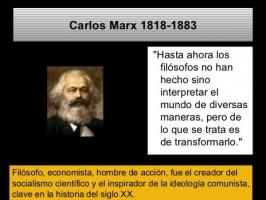3 important CINQUECENTO SCULPTORS and their works

The sixteenth century lived the moments of greatest taste for the classicism of the Renaissance. A period known as Cinquecento and in which balance and harmony triumph that the Quattrocento had already advanced. During this period, the artistic capital moved from Florence to the Rome of the Popes, new patrons and protectors of the artists. An art whose main patrons are Julius II and Leo X, popes who will use art as an instrument of their power and personal prestige, as well as the might of the Church.
In this lesson from unPROFESOR.com we offer you the life and work of the important Cinquecento sculptors so that you know the grandeur and monumentality of the classical sculptures discovered in Rome and that had such an impact on the artists of the time.
Index
- What are the main sculptors of the Renaissance?
- Michelangelo Buonarroti (1475-1564)
- Benvenutto Cellini (1500-1571)
- Juan de Bolonia or Giambologna (1529 - 1608)
What are the main sculptors of the Renaissance?
Among the most important sculptors of the Cinquecento are Miguel Ángel Buonarroti, Donato d'Angelo Bramante, Benvenutto Cellini and Juan de Bolonia, among others. Next, we are going to analyze each of these Renaissance artists So that you can better know his work, his technique and his style. Attentive!
Michelangelo Buonarroti (1475-1564)
Michelangelo is the most important sculptor of the 16th century, being one of the most complete artists the moment being also a painter and architect. Born in 1475 in Caprese, in Tuscany, he worked for more than 70 years in Rome and Florence for patrons such as the Medici of Florence and different Roman Popes.
Characteristics of Michelangelo's sculpture
- Michelangelo demonstrates a great knowledge of human anatomyto. A knowledge that allows him to faithfully represent all the details of the human body. So much so that in the famous sculpture The David, Only a small anatomical error has been detected, already recognized by the author himself and which he attributed to the numerous failures in the block of marble on which he sculpted the work. Thus, an investigation of the professors and anatomy of the University of Florence showed how the error was located between the spine and the right shoulder blade, although the rest of the work is an example of anatomical precision.
- The sculptures of him seem to be in tension, as in the moment just before moving.
- The expression on their faces is also one of his constants, especially his gaze and expression full of intensity and drama, a characteristic known as "Terribilitá".
- Also the bodies are filled with vitality, dynamism and drama twisting and twisting to manifest that tension and movement. A composition called "serpentinata".
- The classical influence it is thus remarkable in all his work.
Most important works of Michelangelo
Among the most important works of Michelangelo are:
- Drunken Bacchus (1498). First great work of Miguel Ángel.
- The Vatican Pietà (1498) is commissioned by the French Cardinal Jean de Billheres, a member of the court of Pope Alexander VI.
- The David, in Florence, (1501) was commissioned by the members of a brotherhood of the Florence Cathedral. The statue represents David defeating Goliath, just prior to throwing the stone.
- The tomb of the Medicis (1519-1534), in the new sacristy of San Lorenzo.
- The tomb of Pope Julius II (1505) funerary monument for Pope Julius II and installed in San Pietro in Vincoli, Rome.
- The Moses, central part of the tomb of Pope Julius II.
- Madonna of Bruges (1504), located in the Church of Our Lady of Bruges in Belgium.
Benvenutto Cellini (1500-1571)
Cellini was a Florentine sculptor, goldsmith and writer who became one of the great goldsmiths of the Renaissance. A disciple of Michelangelo, Cellini worked for the Roman aristocracy, doing many jobs under the patronage of Cosimo I de Medici. Without a doubt, he is another of the important Cinquecento sculptors and, therefore, we are going to analyze his work below.
Cellini main features
- It is true to reality, without disproportion, although it also tends to a certain idealization.
- He uses the lost wax technique, a type of molding used in classical antiquity and that consists of obtaining metal figures from a mol-de made from a wax molding of Bee.
- His style evolved towards Mannerism representing the figures in a more exaggerated way in the forms, lengthening the members of the body.
Cellini's most outstanding works
Among his most important works are:
- A bronze bust of Cosimo I.
- The sculpture "Perseus and the Medusa" with influences from the Florentine school, Michelangelo and Raphael. It is located in the Loggia of Florence.

Juan de Bolonia or Giambologna (1529 - 1608)
He was a Flemish sculptor specialist in bronze and marble works of mythological themes who worked in Italy, being a great student of the work of Michelangelo and the classical sculptors. He is already immersed in the Mannerist era, very inspired by classical antiquity.
Although his style is very faithful to Michelangelo's, Giambologna had his own style by opting for a more elegant and refined line.
Most outstanding works
Among his main works stands out
- Equestrian statue of Cosimo I de Medici
- "The Mercury"
- The Fountain of Neptune in Florence
- Abduction of the Sabine Women

If you want to read more articles similar to Important Cinquecento sculptors, we recommend that you enter our category of Story.
Bibliography
- Gromling, A, (2000) Miguel Ángel Buonarrotti: Life and work, H.F. Ullmann
- Toman, R, (2011) Renaissance: Architecture, sculpture and painting, H.F. Ullmann


